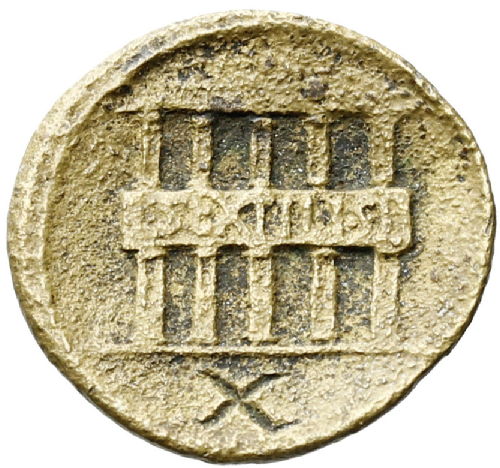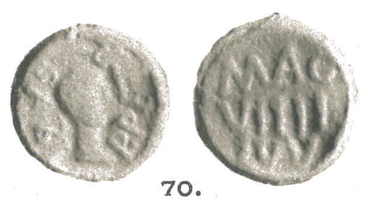All 1 entries tagged Sextili
No other Warwick Blogs use the tag Sextili on entries | View entries tagged Sextili at Technorati | There are no images tagged Sextili on this blog
August 17, 2017
Gaius Mitreius, Magister Iuventutis, and the Materiality of Roman Tokens
Amongst the ancient tokens kept in the coin cabinet of the Ashmolean Museum in Oxford is this piece struck from brass (orichalchum). One one side is a male bust (perhaps of Mitreius or more generally a representation of "youth") surrounded by the legend C. MITREIVS L. F. MAG. IVVENT - Gaius Mitreius, son of Lucius, master of the youth (the iuventutes was a youth organisation). On the other side is a two-story building with columns that looks very much like a basilica. On the building is inscribed L. SEXTILI∙ S.P. = Lucius Sextilius, at his own expense.
 |
 |
Token from the Ashmolean Museum (Oxford). (20mm, 3.58g, die axis 6).
In his analysis of Roman tokens Rostovtzeff discusses this type (p. 60), noting that the example in Paris has a countermark underneath the bust. This piece has the number X (10) etched into the exergue on the reverse, but other specimens carry the numbers VIIII and IIII. The structure on the reverse also varies on different examples (as is typical of numismatic representations of buildings) - other representations show a more circular structure that has been identified as an amphitheatre. The representation of the same or similar scenes with differing numbers is reminiscent of the famous spintriae, bronze tokens that carry sex scenes on one side and differing numbers on the other. The fact that the numbers appear to be incised into the token after it was struck is also similar to a practice known in late antiquity, where contorniates (late antique tokens whose purpose remains debated) where inscribed with Christian symbols, palm branches or other designs after striking. One example of this practice is shown below on a piece from the British Museum: a palm branch has been etched into a contorniate that shows Homer on one side and Bacchus on the other.
 |
We don't know anything further about the Lucius Sextilius named on the token, nor about Mitreius beyond the fact that he held an office connected with the iuventutes, the youth organisations that existed in the western part of the Roman Empire (also known as collegia iuvenes). But we do possess inscriptional evidence for the Mitreius name at Rome and in Gubbio (CIL VI, 28976 and 38641, CIL XI, 5861, AE 1988, 347). A Mitreius token like that shown above was reportedly found on the island of Capri, although this specimen is now lost (Federico and Miranda 1998, 363).
This was not the only token struck by Mitreius in connection with his position as magister iuventutis. He also struck a type with the same obverse (a male bust and his name) with a facing lion's head within a wreath on the reverse. Other bronze types carried the same obverse with a number within a wreath on the reverse (IIII, XI and XII are known - Cohen VIII 12-15, and Triton IV, 449, the specimen pictured below) - this again is very similar to the design of spintriae. Another specimen, now in a private collection, carries Mitreius' name and a tripod on one side and two clasped hands with a poppy seed on the other - this token also appears to be countermarked in the image.
Mitreius was not the only official connected to Roman youth organisations to strike tokens; several types exist in lead that refer to youth groups or to festivals connected to these same groups. One example is shown below: on one side is a youthful male portrait with the legend PPETRI SABI (Publius Petronius Sabinus) and on the other side is the legend MAG VIIII IVV (Magister Iuvenum VIIII - Master of the Youth, Nine) (TURS 834).
 |
 |
| Mitreius bronze token. | Sabinus lead token. |
That officials associated with youth organisations struck tokens in orichalcum, bronze and lead suggests that different materials might be used for tokens that were ultimately used in the same context. In this sense we should study all Roman tokens together as one class of material, rather than, as has previously been the case, separating the bronze from the lead, or the "spintriae" from other types. Clay tokens are also known from Rome, and may also ultimately provide further illumination on what, and in what contexts, these objects were used for. But these types are further evidence that some tokens were used within Roman colleges or other organisations, and may ultimately have been connected to feasts, games, celebrations or festivals.
This blog was written by Clare Rowan as part of the Token Communities Project. Thanks are due to Denise Wilding for undertaking the photography and recording of this and other tokens from the Ashmolean collection.
Bibliography:
Federico, E. and E. Miranda, eds. (1998). Capri Antica. Dalla preistoria alla fine dell'età romana. Capri, Edizioni La Conchiglia.
TURS - Rostowzew, M. (1903). Tesserarum urbis romae et suburbi. St. Petersburg.
Rostowzew, M. (1905). Römische Bleitesserae. Ein Beitrag zur Sozial- und Wirtschaftsgeschichte der römischen Kaiserzeit. Leipzig, Dieterich'sche Verlagsbuchhandlung.
 Clare Rowan
Clare Rowan

 Please wait - comments are loading
Please wait - comments are loading

 Loading…
Loading…

